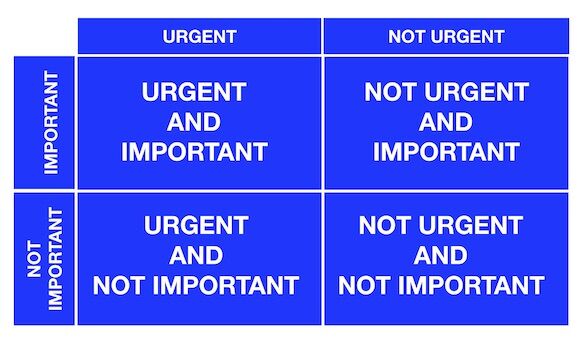Do you feel like you’ve been on red-alert, scrambling for the past six months? If so, you aren’t alone! For many leaders, dealing with and adapting to day-to-day disruption and uncertainty in their organizations has been all-consuming. Who has time to navigate the ship when you are busy plugging leaks and bailing water?
So this is a reminder. Time to “reset” and get back to the work of leading your organization — not just through the next week, but through the next year or more. That means getting back to a more thoughtful approach to prioritizing and accomplishing your work.
We are fans of the Eisenhower Matrix. Originally developed by General Dwight Eisenhower during World War II and featured in Stephen Covey’s The 7 Habits of Highly Effective People, the matrix is an elegantly simple way to categorize and manage your work — from the most mundane tasks to big picture strategic initiatives.
The matrix is pretty self-explanatory and covers virtually any work we might encounter. All tasks, projects, to-dos, and wish lists fall into one of these categories.
Is a monthly report for the Board due before the end of the week? That is both urgent and important. Do that right away!
Is there a meeting this afternoon to review an operational topic? This may be urgent, but not very important. Can you delegate that?
What is your go-to market strategy for 2021? The strategy may not be urgent — the analysis is not due until December 1 — but it certainly is vitally important! This is the critical, long-term stuff. Schedule time on a regular basis to work on that plan.
Lastly, let’s be honest, are there things we do on a routine basis simply because we’ve gotten into the habit of doing them on a routine basis? Is there “work” you do that helps you avoid doing real work? Those things are neither urgent nor important. Stop doing them. (For more, read “Are Your Work Habits Helping or Hurting You?”).
4 Tips to Help Make The Matrix Work For You
1. It’s OK to start small. Look at your to-do list for tomorrow or what’s on your calendar for next week. Take those items and place them in whatever category you think best fits. Upon further review, it’s alright to change your mind!
2. Practice “Do It; Plan It; Delegate It; Stop It.” It’s not going to be perfect right away. There will be missteps and lapses. But this is a marathon. No one ever woke up one morning thinking, “I need to get into better shape. I think I’ll run a marathon today!” Mental muscle, stamina, persistence, and sharpening your decision-making skills are built up over time. Practice, practice, practice.
3. The upper right hand quadrant — “not urgent/important” — is the most strategic, yet most neglected quadrant. It’s easier to deal with the urgent brush fires of the moment than to take the time to think creatively, plan, analyze, and develop big-picture initiatives. It’s easy to push off that “due December 1” project in August, September, and October. Then suddenly, it’s a crisis. Schedule blocks of time, even 30 or 45 minutes, on a regular basis to work on your not urgent/important projects. Schedule it in your calendar and don’t break those appointments you’ve made with yourself!
4. Test your “stop it” list. It can be hard to eliminate something. Try a test. Whatever the thing is in your not urgent/not important quadrant — a standing meeting, a routine report, an office ritual — quietly and without fanfare, eliminate it and observe the reactions and responses. Did anyone notice or care? Is there any negative impact on your important work? If the answer is no, congratulations, you have found something you can live without.
Time to reset, prioritize, and get back to thinking strategically! (For more about using the Eisenhower Matrix, read “How to Get the Big Things Done”).
To learn more about managing your projects and priorities to become a stronger leader, contact Arden Coaching at info@ardencoaching.com or 646.684.3777.

